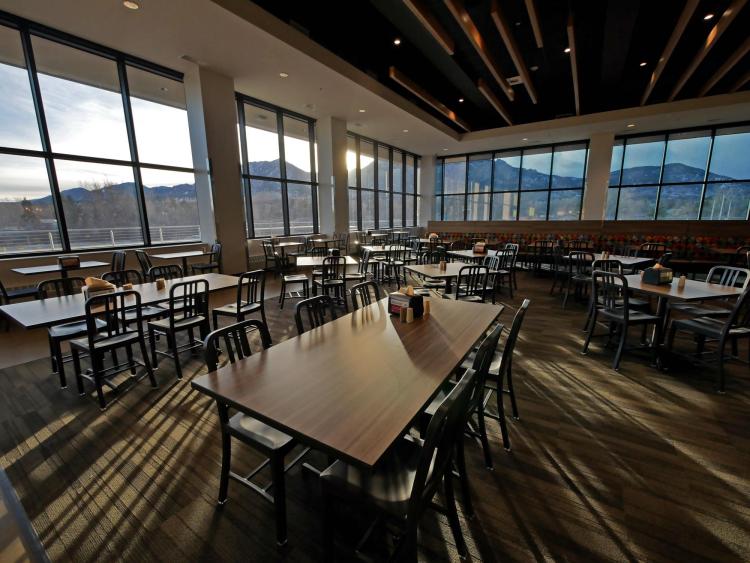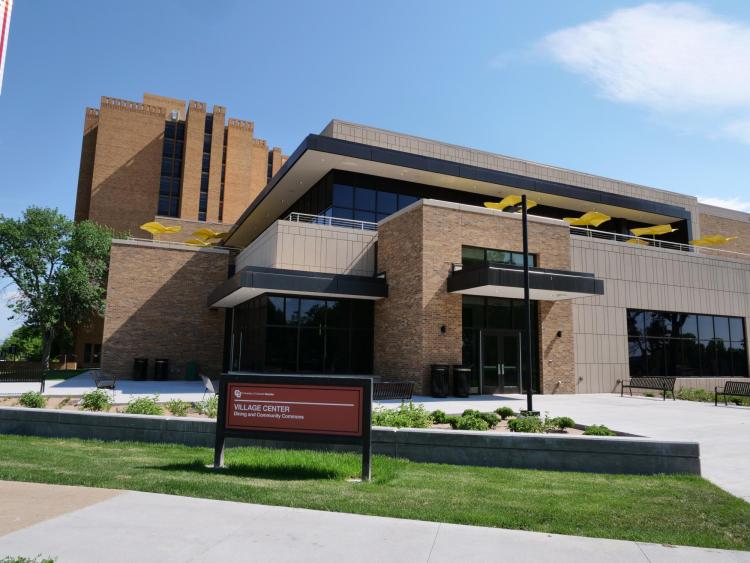Village Center Dining and Community Commons notches LEED Platinum
Mix one part bicycle-powered smoothie station, one part aeroponic garden, one part electrochromic glass and a whole lot of mindful design, and you’ve got the recipe for a LEED Platinum university dining facility.
CU Boulder’s Village Center Dining and Community Commons has been awarded the status by the United States Green Building Council, bringing the number of buildings on campus with the LEED Platinum certification to 11.
Opened in 2017, the 113,225-square-foot Village Center is a hub of student life on CU Boulder’s Williams Village campus. In addition to the dining center, the building features a host of services, from residential programs, to healthcare and counseling, to a campus startup hub for innovation and entrepreneurship.

The latest recognition gives CU Boulder 28 LEED-certified buildings in all, including 11 Platinum, 16 Gold and one Silver. LEED, or Leadership in Energy and Environmental Design, is a globally recognized symbol of excellence in green building, with certification ensuring energy cost savings, lower carbon emissions and healthy work environments.
Williams Village, a residential campus that will house roughly 3,600 students this fall, is becoming a showcase for green building practices. The Williams Village North residence hall was the first residence hall in the country to earn LEED Platinum status when it opened in 2011. The new 700-bed Williams Village East residence hall, meanwhile, opens this fall and is also tracking toward Platinum certification.
“Our students care about sustainability and environmental impact,” said Christina Gonzales, CU Boulder vice chancellor for student affairs. “So as we build and renovate our residence halls and buildings we’ve made sure sustainability is front and center in the designs. By recommending a greenhouse and eco-friendly solutions, our students played a key role in the design and development of the Village Center. The Village Center is also a shining example that came to fruition through the collaboration of many campus departments.”
Some of the notable sustainable features of the Village Center include:
- Electrochromic glass external windows on the south and west sides of the building darken when direct sunlight hits them, which increases energy efficiency, eliminates the need for window blinds and leaves beautiful mountain views in sight all day long.
- A 140.5-kilowatt solar array offsets 16 percent of the building’s annual energy cost.
- A 3,000-square-foot aeroponic garden supplies the dining center with fresh salad greens, reducing the need for packing and transporting food from outside farms.
- A biodigester used to treat food waste, which creates an eco-friendly product that can be safely added to the wastewater system and reduces food composting collection costs.
- Smoothie station featuring a bicycle-powered blender.
- By cost, 31 percent of building materials are recycled and 48 percent were manufactured and extracted from within 500 miles of the project site. More than 60 percent of construction waste was diverted from the landfill.
- Water efficient flow and flush fixtures coupled with an efficient irrigation system and native and adaptive plants used in landscaping expected to result in more than 450,000 gallons of reduced water use each year.
- 38 percent energy use savings versus a similar baseline building.
- LED lighting throughout the building.
- The entire second-floor dining center seating area uses daylighting (along with skylights) in lieu of artificial light between the hours of 9 a.m. and 3 p.m.
- About 40 percent of dining room chairs made completely of recycled plastic material—111 20-ounce plastic bottles in each of the 181 chairs, to be precise.
- 6 custom wood dining tables, each seating 12 people, built using 100 percent beetle-kill wood from the Kremmling, Colorado area.

"We are so grateful to have been part of the Village Center team,” said Group14’s Lauren McNeill. “Working with CU Boulder always allows us the opportunity to be truly collaborative and innovative when it comes to sustainable design practices and this project exemplified an integrative design process. CU had everyone around the table early and often to ensure that we delivered the best building possible with sustainability at the forefront of the design. CU's achievement of another LEED Platinum building is a testament to their hard work and dedication to their staff, students, future generations and the environment."


